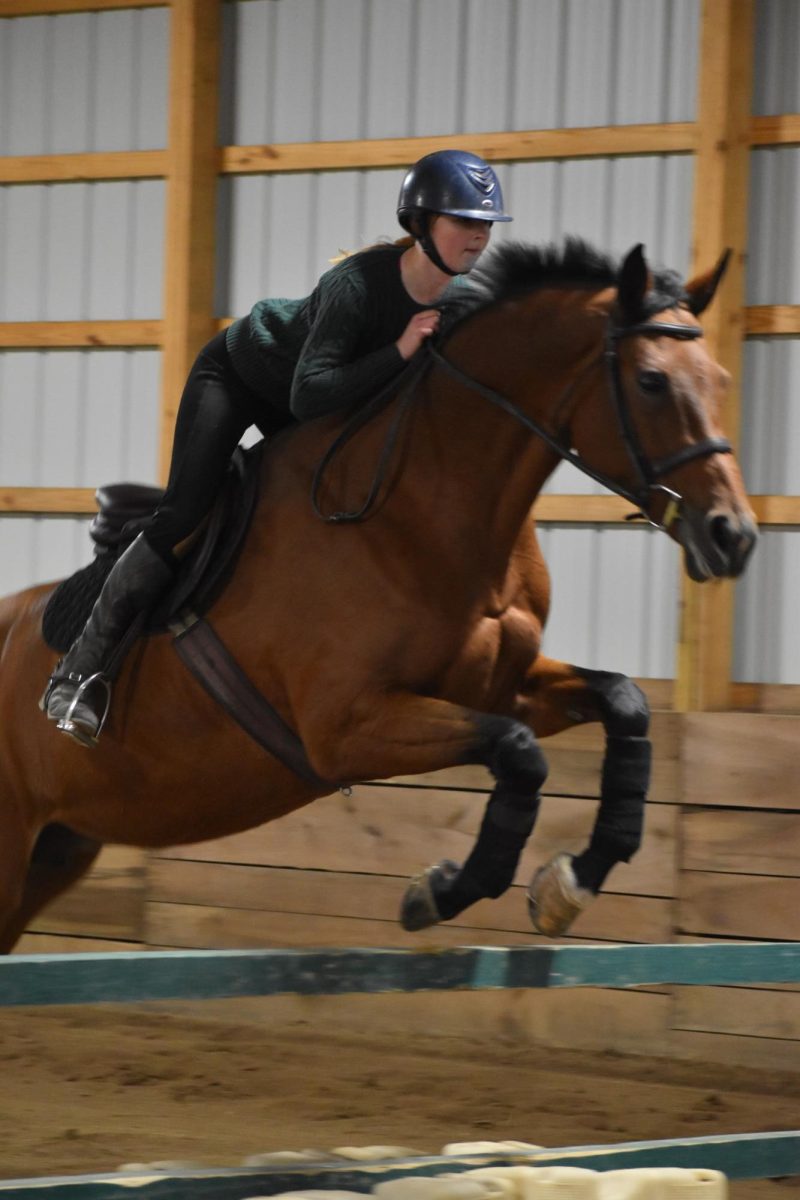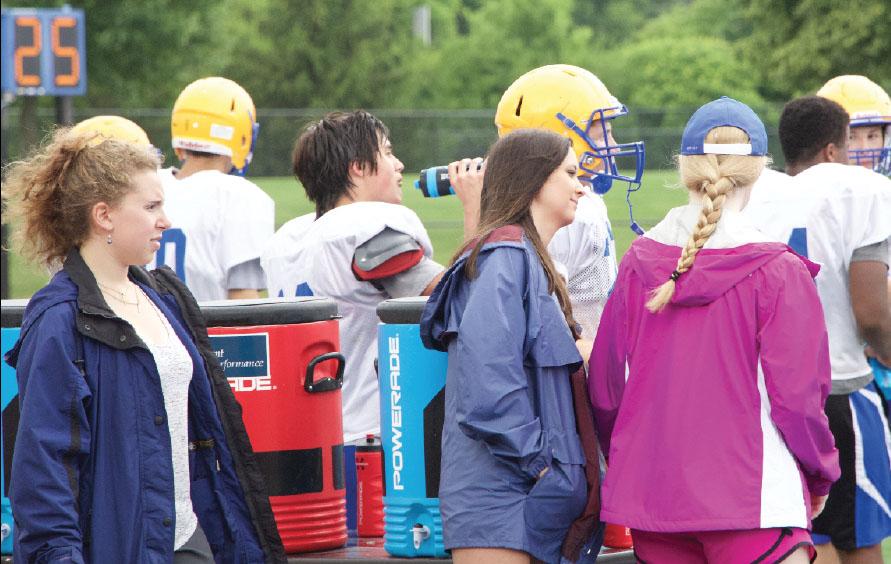At the end of every school day, Mallory Qualls, student athletic trainer and senior, walks down the trail to the football stadium’s training room. Shortly after arriving, she boards the bus with all the other women’s soccer players and sits in the back with the other athletic trainers. The bus ride is routine, but it is still filled with high-pitched laughter, new gossip and loud, unashamed Disney karaoke.
Qualls is a student athletic trainer, a sports medicine-based student organization at CHS. They work under certified athletic trainers like Anna Foster and Brittani Moore, certified athletic trainer for CHS through St. Vincent’s Sports Performance. According to Foster, any sport approved by the Indiana High School Athletic Association (IHSAA) has specialized student athletic trainers.
“Student (trainers) are an extension of us as athletic trainers. So on a typical day, we have students that come in with injuries. We do the evaluation process, we do all of the different things they need in regards to making sure they’re healthy. Our student athletic trainers help out in regards to game set up. They observe and get an idea of what an athletic trainer career is like, what a sports medicine profession is like,” Foster said. “We show them how to do different rehabs and they get to understand the rehab process. Basically as an extension of who we are, they help us be the eyes and ears on the field.”

Francie Elzinga, student athletic trainer and junior, said student trainers help certified trainers like Foster and Moore, by covering more bases. A trainer helped Connor Inglis, men’s soccer player and senior, last year through light injuries and stretches during his season.
She follows the basic guideline of being a student trainer. Her responsibilities include covering all practices, away and home games, and travelling with the JV teams. Moore said that these students are not allowed to evaluate injuries or begin unassisted rehabilitation for the athletes because they do not have the appropriate sports management training or medical education. Therefore, their help is restricted to the following: making ice bags, wrapping ice bags, taping injuries, helping with splinting, stretching tight hamstrings and quads, getting ice, keeping the injury clean, AED and applying ointments on band-aids.
According to the National Athletic Trainers’ Association (NATA), out of its 30,000 members, 4,000 of them are students. CHS has also seen an increase in student trainers as well. Training is a perfect mix between passion for helping others and career experience for sports medicine, Elzinga said.
“(Becoming an athletic trainer) is becoming a more popular thing. People are starting to be more aware of what a trainer is. And especially (for) the kids who like sports but aren’t necessarily good or they don’t want to be on the team and compete competitively at the school, they can still be involved in something with the sport,” Moore said.
At CHS, student athletic trainers receive a certification for the first sport they train, a varsity letter for the second sport and a varsity jacket for their third sport. Foster said she believes this increase in student trainers is due to students becoming more curious to what a professional athletic trainer does and what the sport’s medicine world is like. Foster was a student athletic trainer at her high school and has been an athletic trainer for 13 years; she said she definitely sees the appeal in student training for hands-on experience opportunities. Moore also stresses the fact that the affinity for becoming an athletic trainer comes from the relationship trainers build with the athletes. Moore recently moved as a trainer from Creekside Middle School to CHS. She said that seeing the kids she helped heal in middle school grow up and continue to play the sport they love in high school is extremely rewarding.
“Moving along, you kind of get invested in the kids themselves also. You build a strong relationship with them. They trust so you’re their mentor and you want to help them be better athletes. You want to help them get better. I love the fact that they are able to come to me if they need help or if they’re upset and you can give them help,” she said.
According to both Elzinga and Qualls, becoming a student trainer has allowed them to form a special bond with the athletes on the team. The family aspect is definitely a pro. Not only does a student athletic trainer feel like a member of the sports team, but also feel as family with all the other student athletic trainers, dubbed the “Trainer Fam.”
Qualls said in a more serious injury, student trainers help the injured athlete remain calm while the athletic trainers evaluate their injury and call the emergency room if necessary. She said seeing an athlete’s injury in their time of vulnerability and reassuring him or her of their care, creates a support team between sport player and student athletic trainer. Foster believes this is one of the highlights of training for a sport.

Senior Mallory Qualls fills waters as she watches the football team practice. Trainers do more than “water boy” duties and are essential to injured players, helping with recoveries by wrapping injuries and stretching out different muscles.
“Probably one of the most rewarding things about being an athletic trainer is being able to see a kid’s injury from start to finish. You’re there when they get hurt. You’re there when they go to the doctor. You’re there when they get their diagnosis and you get the option of sitting in on a surgery with them. You get that ability to treat them from the very beginning to the very end. Then you get the ‘proud momma or papa’ moment where you see them get back to the sport they love,” Foster said. “You did everything you loved to do and seeing them get to take the first swing at the bat or when they go out and get their first hit as a player coming back from an injury is something that is super rewarding to know that you were behind that person and supporting them through the entire tragedy.”
After the injury, student athletic trainers, under the watchful eye of athletic trainers, begin to help the athlete stretch out and go through rehabilitation.
“If we’re stretching them out, a lot of times our athletes will start to cry, because obviously it’s very painful. We try to keep a conversation going and get their minds off what they’re going through … During a soccer season, a girl tore her ACL during an invite and when that happened we had to get her off the field, get her checked out. Luckily the game was at home, so we had our trainers look at her—which I think is really nice to have someone you know look over your injuries. So we just had to help her calm down and get all her stuff so her parents could take her to the hospital,” Qualls said.
Both certified and student athletic trainers do not often receive much recognition for their work. According to Elzinga, their jobs are behind the curtains; giving treatment to injured athletes to return to the sports they love. She said CHS does a great job of making student athletic trainers feel appreciated.
“They sit with us through the whole bus ride (to games). I remember when we were in Evansville for semis; they were with us the whole time and just hanging out. My experience with them was awesome. They really are an important part of our team.” Inglis said.
Qualls said as trainers are brought on the team, the coaches treat them like one of their own. Trainers get the same favors the athletes get with dinner at away games, acknowledged at convocations and they are recognized on Senior Night if they’re seniors. Elzinga said both players and coaches treat student trainers with respect. Furthermore, as members of the team, they participate in team bonding events with the players, strengthening the chemistry and trust between the team and the player.
“We’re definitely seen as members of the team (by the coaches). When they get food, we get food. We’re invited to all the team events that they do and not just the practices, like bonfire bonding … I think (athletic training is) a lot of fun and I don’t really need the recognition from other people. I’m just here to help. As long as the team appreciates what we’re doing, then I’m happy,” Qualls said.


































![British royalty are American celebrities [opinion]](https://hilite.org/wp-content/uploads/2024/03/Screenshot-2024-03-24-1.44.57-PM.png)



















![Chelsea Meng on her instagram-run bracelet shop [Biz Buzz]](https://hilite.org/wp-content/uploads/2024/04/IMG_2446-1200x838.jpg)
![Review: Quiet on Set: The Dark Side of Kids TV is the long awaited exposé of pedophilia within the children’s entertainment industry [MUSE]](https://hilite.org/wp-content/uploads/2024/04/unnamed.jpg)
![Review: “The Iron Claw” cannot get enough praise [MUSE]](https://hilite.org/wp-content/uploads/2024/04/unnamed.png)
![Review: “The Bear” sets an unbelievably high bar for future comedy shows [MUSE]](https://hilite.org/wp-content/uploads/2024/03/unnamed.png)
![Review: “Mysterious Lotus Casebook” is an amazing historical Chinese drama [MUSE]](https://hilite.org/wp-content/uploads/2024/03/0.webp)
![Review in Print: Maripaz Villar brings a delightfully unique style to the world of WEBTOON [MUSE]](https://hilite.org/wp-content/uploads/2023/12/maripazcover-1200x960.jpg)
![Review: “The Sword of Kaigen” is a masterpiece [MUSE]](https://hilite.org/wp-content/uploads/2023/11/Screenshot-2023-11-26-201051.png)
![Review: Gateron Oil Kings, great linear switches, okay price [MUSE]](https://hilite.org/wp-content/uploads/2023/11/Screenshot-2023-11-26-200553.png)
![Review: “A Haunting in Venice” is a significant improvement from other Agatha Christie adaptations [MUSE]](https://hilite.org/wp-content/uploads/2023/11/e7ee2938a6d422669771bce6d8088521.jpg)
![Review: A Thanksgiving story from elementary school, still just as interesting [MUSE]](https://hilite.org/wp-content/uploads/2023/11/Screenshot-2023-11-26-195514-987x1200.png)
![Review: When I Fly Towards You, cute, uplifting youth drama [MUSE]](https://hilite.org/wp-content/uploads/2023/09/When-I-Fly-Towards-You-Chinese-drama.png)
![Postcards from Muse: Hawaii Travel Diary [MUSE]](https://hilite.org/wp-content/uploads/2023/09/My-project-1-1200x1200.jpg)
![Review: Ladybug & Cat Noir: The Movie, departure from original show [MUSE]](https://hilite.org/wp-content/uploads/2023/09/Ladybug__Cat_Noir_-_The_Movie_poster.jpg)
![Review in Print: Hidden Love is the cute, uplifting drama everyone needs [MUSE]](https://hilite.org/wp-content/uploads/2023/09/hiddenlovecover-e1693597208225-1030x1200.png)
![Review in Print: Heartstopper is the heartwarming queer romance we all need [MUSE]](https://hilite.org/wp-content/uploads/2023/08/museheartstoppercover-1200x654.png)






















![Review: Ladybug & Cat Noir: The Movie, departure from original show [MUSE]](https://hilite.org/wp-content/uploads/2023/09/Ladybug__Cat_Noir_-_The_Movie_poster-221x300.jpg)

![Review: Next in Fashion season two survives changes, becomes a valuable pop culture artifact [MUSE]](https://hilite.org/wp-content/uploads/2023/03/Screen-Shot-2023-03-09-at-11.05.05-AM-300x214.png)
![Review: Is The Stormlight Archive worth it? [MUSE]](https://hilite.org/wp-content/uploads/2023/10/unnamed-1-184x300.png)




